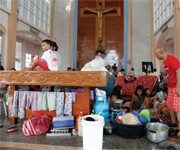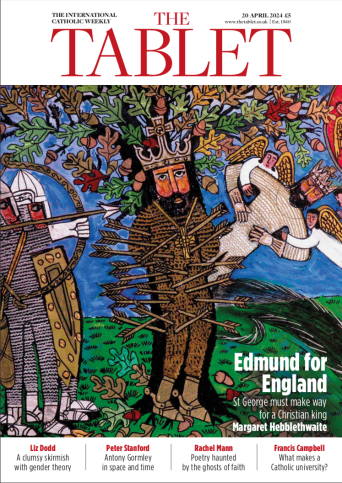Once the dead have been buried and survivors’ immediate needs met, thoughts turn to restoring communities shattered by the most powerful typhoon on record that tore indiscriminately through town and country on the fragile islands of the Philippine archipelago
Getting emergency aid to all the victims of Typhoon Haiyan has been logistically daunting. Infrastructure has been damaged or destroyed and torrential rain has also hampered the relief teams this week. But, as with the Boxing Day tsunami of 2004 and the earthquake in Haiti in 2010, the task of rebuilding shattered communities in the central Philippines will pose much greater challenges.
Roads, communications systems, homes and public buildings will have to be rebuilt with pressure to make these storm- and earthquake-proof. The issue of preparedness for natural disasters will be higher on the agenda in this most susceptible of countries. And, given the Philippines’ reputation as one of the most corrupt economies in Asia, there will be anxieties that funds are not going where they should.
On Friday 8 November, Typhoon Haiyan – a Category-5 super typhoon with winds gusting at nearly 200 miles an hour, and tsunami-like waves of up to 19 feet – swept into coastal areas, destroying virtually everything in its path. The storm first hit the islands of Samar and Leyte, then the northern tip of Cebu and on through the centre of Panay before heading to Vietnam and China, gradually diminishing in ferocity.
In Leyte province alone, the death toll was initially estimated at around 10,000, although on Tuesday, President Benigno Aquino III said between 2,000 and 2,500 people had died. The first relief workers to arrive in the Leyte province’s coastal capital, Tacloban, about 360 miles south-east of Manila, painted an apocalyptic scene.
“Patients are overflowing from the regional hospital in Tacloban. There are dead people everywhere. There is no water or power. Volunteers are trying to manage the disaster. It looks as if nuclear bombs were dropped,” said Rey Barnido, one of Cafod’s Caritas partners in a text to his colleagues.
Fr Edwin Gariguez, executive secretary of Caritas Philippines-NASSA, said the size of the storm was beyond all expectations, adding: “There are dead bodies everywhere. People are traumatised. The most urgent needs are for food and water.” His remarks were echoed by Christian Aid’s senior programme officer for resilient livelihoods, Alwynn Javier, who said: “This is on a scale never seen before. It has covered a vast area, including islands where the infrastructure was already limited.”
Some observers believe that this epic disaster was made worse by humanity: through the impact of man-made climate change (see box below) and by corruption. Power lines and phone lines are down, and roads blocked by debris or destroyed, with the result that aid teams had still not reached some coastal villages by Wednesday of this week.
According to Steven Rood who runs the Asia Foundation’s office in Manila, corruption is indirectly responsible for the dearth of roads on some of the islands and for the fact that those that exist were not built to the correct specification and were therefore more susceptible to damage from the typhoon.
On Tuesday, the United Nations announced an appeal for £190 million to fund the relief effort. It released US$25m (£15m) in emergency funds to provide food, temporary shelters, health services, drinking water and sanitation. The UN estimated that 11 million people had been affected by the storm and 673,000 had lost their homes.
A British warship, HMS Daring, and an RAF transport aircraft were sent to the region. On Tuesday, David Cameron told President Aquino that the United Kingdom would contribute £6m of immediate aid. The United States sent an aircraft carrier, USS George Washington, with a fleet of helicopters that will drop supplies to otherwise inaccessible areas. The aid, though, will be no use unless it gets through to people desperate for help, and the lack of roads was causing major problems. Reports are emerging of looting, including that of a government building in Leyte where 100,000 sacks of rice were taken.
In the world’s third-largest Catholic country, the Church is playing a major role in both raising funds for the victims and delivering aid. With church agencies well established on the ground, they have been able to move quickly. The Church’s relief effort is being spearheaded by Caritas Internationalis, the worldwide umbrella organisation of Catholic aid agencies. Its members include Cafod, the aid agency for England and Wales, Caritas Philippines, and Catholic Relief Services, the American Church’s aid agency.
Caritas member organisations have pledged £1.25m to the aid effort. The Caritas Manila office was transformed into a loading centre last Sunday with 250 volunteers working in shifts to prepare food packs containing tinned goods, rice and noodles. Each pack was designed to last a family of five for three days. The first consignment was flown to Leyte on Wednesday. Most of the volunteers were said to be from local youth groups. The aim is to send 20,000 food packs in the next few weeks.
Sr Anne Healy, an Irish nun and member of the Sisters of the Sacred Hearts of Jesus and Mary who run an urban development programme in poor slum communities in the southern province of Cebu, was helping to deliver food to 3,000 people, many of them children. “It’s a desperate situation. Local people are donating clothes to people who lost everything, so that allows us to focus on getting food. [Because of shortages] the price of food has gone up so many people can’t afford to buy it. We have been able to buy rice and other products at local markets and distribute it to people,” said Sr Anne.
In Catbalogan City, Western Samar, a local church official reported on Wednesday that long queues were forming in shops and the price of food and other essentials was soaring. “Victims here in Western Visayas need food, they are already hungry. What we need right now are water, easy to open foods or canned goods, candles and matches. These are the immediate concerns,” said Fr Cesar Aculan, social action director of the Diocese of Calbayog.
Caritas was also preparing to distribute emergency shelter kits to people living in the open. These include a 258-foot-square tarpaulin and nails for fastening it to an A-frame made from salvaged materials. Other priorities are water, hygiene and sanitation kits.
Cafod is one of the 14 agencies that make up the British Disasters Emergency Committee which launched an appeal on Tuesday. The agency’s director, Chris Bain, said Cafod’s emergency appeal is in response to the individuals, schools and parishes that have contacted its headquarters to ask what they can do. “The best way we can all help is by supporting the charities and church groups who are already operating in the worst-hit areas, responding to their immediate needs for food, water and shelter, beginning the hard work of rebuilding the communities that have lost everything, and keeping them constantly in our prayers. Together, we can bring new hope to those who today face utter desolation,” said Mr Bain.
The typhoon hit some of the same areas that were affected by an earthquake on 15 October which left thousands of people homeless on Bohol island. Cafod was already involved in aid efforts there. Malteser International, the Order of Malta’s international relief agency, has allocated €100,000 (£84,000) towards initial emergency relief measures and launched its own appeal (www.malteser-international.org). It was sending food and hygiene kits to 1,000 families on Samar and three tons of medicines to Leyte.
Odelia Arroyo, emergency relief coordinator for Order of Malta Philippines in Manila, told me on Tuesday that difficulties concerning communications and transport were the main reasons for the slowness in delivering aid. She identified Leyte Province as the worst hit area, followed by Samar. A curfew had been imposed in Leyte’s capital, Tacloban, and people had been ordered to evacuate the city.
Some families were flying from Tacloban’s airport to stay with relatives and friends though were enduring long delays. Others were travelling by road, which had just been made possible by the reopening of the San Juanico Bridge, a 1.34-mile crossing linking Leyte to Samar. Mrs Arroyo reported heavy traffic jams and also a great many people leaving the city on foot, and said with most hospitals in Leyte closed or destroyed, there was a need for mobile clinics and generators. Supplying aid, she added, would be a very long-term project.
These have been anxious days for the Filipino diaspora around the world. Lay missionary in Birmingham, Rosalia Basada, has family living in Hinabangan on Samar, and suffered sleepless nights when one niece was initially unaccounted for. She has since been found safe and well. Ms Basada, who works at a drop-in centre for asylum seekers near St Chad’s Cathedral, returned to England in October after spending four months in the Philippines close to Tacloban. Though distraught at seeing the images of destruction, she said Filipinos were very resilient, adding: “We live in outlying areas and we always experience typhoons. We are very strong and keep the faith in spite of what happens to us.”
Explaining that volunteering to help others at times of disaster was second nature and young people were inspired by their elders’ kindness, Ms Basada said: “We reach out to people in need even if we don’t know each other, even if we are poor. We will do something to help them.”





 Loading ...
Loading ...
What do you think?
You can post as a subscriber user...
User Comments (0)